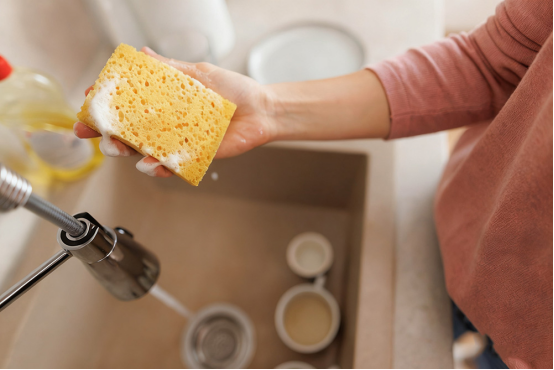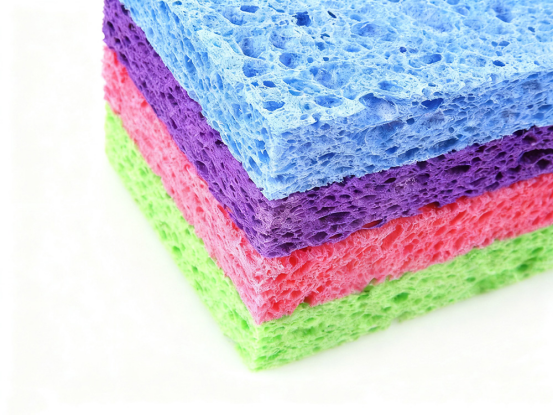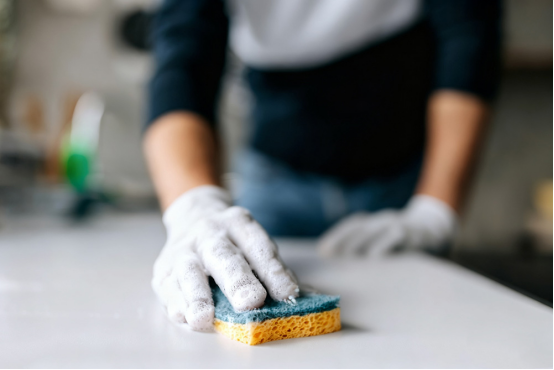Cellulose Sponge or Regular Sponge Which One Wins?

Cellulose sponges offer superior eco-friendliness and gentle cleaning capabilities for various surfaces. Regular sponges, conversely, typically excel in their scrubbing power and initial cost-effectiveness for tougher jobs. The optimal selection between these two depends entirely on specific cleaning tasks and individual priorities.
Key Takeaways
● Cellulose sponges are good for gentle cleaning and the environment. They come from plants and break down easily.
● Regular sponges are strong for tough messes. They often have a rough side to scrub away dirt.
● Choose your sponge based on what you need to clean. Think about if you need gentle cleaning or strong scrubbing.
Understanding Sponge Composition
What is a Cellulose Sponge?
A cellulose sponge originates from wood pulp, making it a plant-based product. Manufacturers create these sponges from regenerated cellulose. The primary raw materials for a cellulose sponge include viscose, cellulose fibers, and crystalline pore-forming materials like sodium sulfate crystals. Other formulations might incorporate hemp fibers or flax. The manufacturing process begins by dissolving wood pulp. Workers then mix this viscose solution with salt crystals, which later dissolve to create the sponge's characteristic porous structure. The material forms into large blocks, which manufacturers then cut into various shapes and sizes.
What is a Regular Sponge?
A regular sponge, often called a synthetic sponge, typically consists of plastic polymers. These sponges are usually petroleum-based. Key raw materials for regular sponges include polyether polyols, isocyanates, and various catalysts. Water acts as a blowing agent during production. The manufacturing process involves combining these raw materials and additives. Workers then inject the mixture into molds using a foaming machine. This allows the material to solidify into a sponge. Heating the solidified sponge in a vulcanization chamber gives it elasticity. After vulcanization, the material is removed from the mold, cleaned, and dehydrated.
Absorbency and Liquid Retention
Sponge effectiveness often depends on its ability to absorb and retain liquids. Different materials exhibit varying capacities for holding water. Understanding these differences helps users select the right tool for specific cleaning tasks.
How Cellulose Sponges Absorb
Cellulose sponges demonstrate excellent absorbency. Their plant-based composition creates a highly porous structure. These interconnected pores act like tiny capillaries. They draw liquid into the sponge through capillary action. The natural fibers of a cellulose sponge are hydrophilic, meaning they attract water molecules. This characteristic allows them to soak up significant amounts of liquid quickly. They can hold many times their weight in water, making them efficient for spills and general wiping.
How Regular Sponges Absorb
Regular sponges, made from synthetic polymers, also possess good absorbent qualities. Manufacturers design these sponges with an open-cell foam structure. This structure creates numerous small pockets throughout the material. Liquid fills these pockets when the sponge comes into contact with water. While they absorb effectively, their synthetic nature means they might not hold liquid as tightly as cellulose sponges. They can release water more easily when squeezed. This property can be advantageous for rinsing or when users need to quickly release absorbed liquid.
Texture and Cleaning Effectiveness
Cellulose Sponge Texture for Cleaning
Cellulose sponges feature a distinctly soft and pliable texture. Their natural, open-pore structure makes them inherently gentle on various surfaces. This smooth texture allows the sponge to glide effortlessly across countertops, dishes, and other household items. It effectively wipes away spills and light dirt without causing scratches. The soft nature of a cellulose sponge makes it an excellent choice for delicate cleaning tasks. It cleans glass, polished wood, and non-stick cookware safely.
Regular Sponge Texture for Cleaning
Regular sponges often present a more varied texture. Many designs feature a dual-sided construction. One side typically offers a soft, absorbent surface for general wiping. The other side provides a rougher, abrasive texture. This unique design specifically targets tough grime. It allows for effective cleaning with gentle, circular motions. The effectiveness of sponges, particularly their scrubbing strength, undergoes rigorous evaluation. Experts conduct laboratory-style durability tests. These tests involve hundreds of scrubbing repetitions on rough surfaces. This process identifies potential issues and assesses wear and tear. For instance, the Scotch-Brite Non-Scratch Scrub outperformed many competitors in sheer scrubbing power. It effectively scours and scrubs away stubborn stains. These sponges often incorporate durable materials, like high-quality mesh fibers. These materials can outlast up to six regular sponges. They also resist trapping food particles. However, not all regular sponges perform equally. Some, like silicone scrubbers, show poor scrubbing power. They struggle to break through grease and grime. Microfiber scrubbers may also wear flat quickly, accumulating grime.
Durability and Lifespan Comparison
Durability of Cellulose Sponge
Cellulose sponges generally offer moderate durability. Their plant-based composition makes them prone to breaking down over time, especially with frequent use and exposure to harsh cleaning agents. The natural fibers can weaken, leading to tearing or crumbling. Under typical household conditions, a cellulose sponge often lasts between four to eight weeks. This average lifespan can vary based on the intensity of cleaning tasks. However, users can extend its lifespan significantly with proper care. This care includes thorough rinsing after each use and allowing it to dry completely. Some reports indicate a cellulose sponge can last up to three months when maintained diligently. Regular cleaning also prevents bacterial growth, which can degrade the material faster and reduce its effectiveness.
Durability of Regular Sponge
Regular sponges, made from synthetic polymers, exhibit varying durability. Their lifespan largely depends on usage and maintenance. Without regular sanitization, a regular sponge typically requires replacement every one to two weeks. This short lifespan is primarily due to bacterial accumulation, which can compromise the sponge's integrity and hygiene. The synthetic material itself can withstand more abrasive use than cellulose, but bacterial growth remains a key factor in its degradation. However, consistent sanitizing practices significantly extend its useful life. Users can prolong a regular sponge's effectiveness to a month or even a month and a half. Effective sanitizing methods include soaking the sponge in a 9:1 water and bleach mixture, microwaving it in water until steaming, or boiling it for five minutes after each use. These methods kill bacteria, maintaining the sponge's cleanliness and structural integrity for longer periods, thus maximizing its utility.
Cleaning Performance for Various Tasks
Cellulose Sponge for Kitchen Cleanup
A cellulose sponge excels in general kitchen cleanup. Its soft, absorbent nature makes it ideal for wiping down countertops, tables, and stovetops. It effectively soaks up spills and removes light food debris without scratching surfaces. Many users find it perfect for washing dishes, especially glassware and everyday plates, due to its gentle touch. It rinses easily, preventing food particles from clinging, which helps maintain hygiene during daily kitchen routines.
Regular Sponge for Tough Grime
Regular sponges, particularly those with an abrasive scrubbing side, demonstrate superior performance against tough grime. Their textured surfaces effectively tackle baked-on food, stubborn grease, and dried-on messes on pots, pans, and oven trays. The rougher material provides the necessary friction to dislodge hardened residue. This makes them indispensable for heavy-duty cleaning tasks where significant scrubbing power is required. They efficiently remove dirt that softer sponges cannot handle.
Best for Delicate Surfaces
For delicate surfaces, selecting the right sponge prevents damage. Certain sponges are specifically designed to clean without scratching. These options include:
● Scotch Brite 'Non Scratch Blue' sponge
● Scotch Brite 'Delicate Pink' sponge
● A blue version of Scotch Brite featuring a light blue sponge and a dark blue scouring pad surface, which is Teflon safe.
● Dobie pads, known for their abrasive plastic material that does not scratch.
● A plain sponge or a blue scrub sponge, serving as an all-purpose tool for gentle cleaning.
These specialized sponges protect non-stick cookware, fine china, and other easily damaged items, ensuring thorough cleaning without leaving marks.
Environmental Impact and Sustainability
Environmental Footprint of Cellulose Sponge
Cellulose sponges present a favorable environmental profile. Manufacturers create these sponges from renewable wood pulp. This plant-based origin makes them inherently biodegradable. Pure cellulose sponges decompose rapidly. They can break down within a few weeks when placed in soil. Research demonstrates sponges made from chitin-cellulose nanofibers lost up to 92% of their mass within 28 days. This rapid breakdown minimizes landfill accumulation. A cellulose sponge typically achieves 90% degradation within six months. This makes them a more sustainable option for daily cleaning tasks. Their natural composition ensures they return to the earth without leaving lasting pollutants, reducing their overall ecological impact.
Environmental Footprint of Regular Sponge
Regular sponges, made from synthetic polymers, carry a significant environmental burden. Their production uses petroleum, a non-renewable fossil fuel. These synthetic materials resist natural decomposition. Regular sponges degrade very slowly. They show only 20-30% degradation over 12 to 18 months. Many synthetic sponges can take hundreds of years to decompose. Some may never fully break down. This contributes substantially to plastic pollution and landfill waste. The table below illustrates the stark difference in degradation rates:
| Material Type | Degradation Rate (%) | Time (Months) |
| Cellulose | 90 | 6 |
| Synthetic | 20-30 | 12-18 |
This slow decomposition makes regular sponges a less sustainable choice. They persist in the environment for extended periods, creating long-term ecological concerns. Their synthetic nature means they do not integrate back into natural cycles.
Cost-Effectiveness Over Time
Initial Cost of Cellulose Sponges
Cellulose sponges typically have a slightly higher initial purchase price compared to their synthetic counterparts. Manufacturers use natural materials and a specific production process. This often translates to a marginally increased cost per unit at the point of sale. Consumers might observe a small price difference when comparing a single cellulose sponge to a single regular sponge in a retail environment.
Initial Cost of Regular Sponges
Regular sponges generally boast a lower initial cost. Their mass production from synthetic polymers allows manufacturers to offer them at a very competitive price. Consumers can often purchase multi-packs of regular sponges for a minimal outlay. This makes them an attractive option for budget-conscious buyers seeking immediate savings.
Long-Term Value of Each Sponge Type
Evaluating long-term value requires considering both initial cost and durability. Cellulose sponges offer a similar cost to traditional cleaning tools. They are also more than twice as durable as most traditional sponges. This enhanced durability, combined with comparable initial cost, suggests a lower total cost of ownership over a one-year period for cellulose sponges. While regular sponges have a lower upfront price, their shorter lifespan often necessitates more frequent replacements. This can accumulate into a higher overall expenditure over time. Therefore, the long-term value favors the more durable option, reducing the need for constant repurchasing.
Hygiene and Maintenance Practices
Cleaning and Sanitizing Cellulose Sponges
Maintaining sponge hygiene is crucial for effective cleaning. Users can sanitize cellulose sponges effectively. Chlorine treatment significantly reduces Salmonella bacteria. Boiling also proves effective in eliminating Salmonella. Running the sponge through a dishwasher cycle provides another reliable method for sanitization. These practices help prevent bacterial growth and extend the sponge's useful life.
Cleaning and Sanitizing Regular Sponges
Regular sponges require consistent sanitization to remain hygienic. Microwaving is a highly effective method. One minute in the microwave can achieve over 6 log bacterial reduction. Dishwashing also provides excellent results, reducing bacteria by more than 5 log. Boiling is another effective option. However, organic soils can diminish the effectiveness of chlorine solutions. Recent research indicates microwaving is the most effective method for cleaning kitchen dishcloths and sponges. Microwaving and dishwashing significantly reduce bacteria, yeasts, and molds. These methods effectively eliminate foodborne pathogens in a home kitchen environment.
| Method | Bacterial Reduction (log) |
| Dishwasher | >5 |
| Microwave (1 min) | >6 |
| Chlorine | Effective |
| Boiling | Effective |
Odor Resistance of Each Sponge
Sponges with integrated antimicrobial technology exhibit greater resistance to developing unpleasant odors. Manufacturers incorporate these additives directly into the sponge material. Antimicrobial technology inhibits the growth of bacteria, mold, and mildew. These microbes are the primary causes of odors. The technology remains effective throughout the product's lifespan. It provides continuous odor control by reducing microbial activity. For example, the Scotch-Brite® Odor Resist Heavy Duty Sponge incorporates 'Odor Resist technology'. This sponge is antibacterial-treated to prevent bacterial odors. It guarantees resistance to bacterial odors for up to three weeks of use.
Eco-conscious users and general absorbency benefit from a cellulose sponge. Regular sponges excel at heavy-duty scrubbing and offer a budget-friendly initial purchase. Your ideal sponge depends on specific cleaning needs, environmental values, and budget.
FAQ
Which sponge is better for the environment?
Cellulose sponges are better for the environment. They come from renewable wood pulp. They are also biodegradable. This reduces landfill waste.
Can users sanitize both types of sponges?
Yes, users can sanitize both types.
Methods include microwaving, dishwashing, or boiling. These practices kill bacteria and extend sponge life.
Which sponge is better for tough scrubbing tasks?
Regular sponges with an abrasive side are better for tough scrubbing. Their textured surfaces effectively remove baked-on food and stubborn grease.
